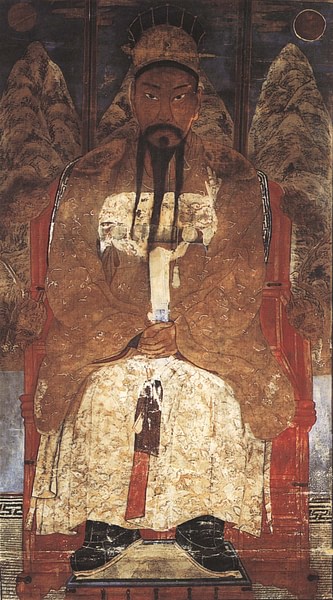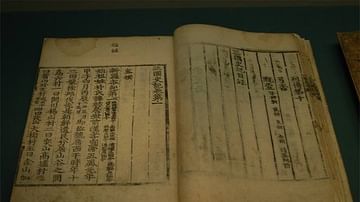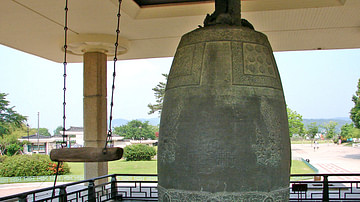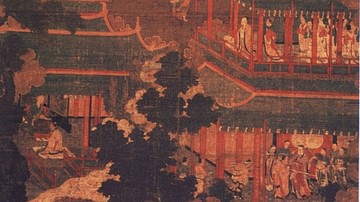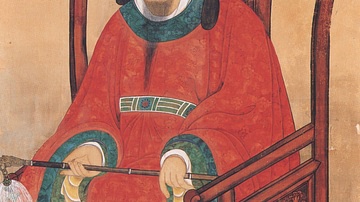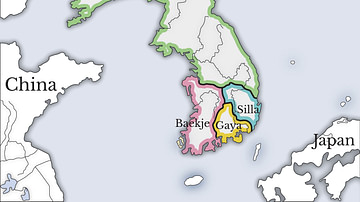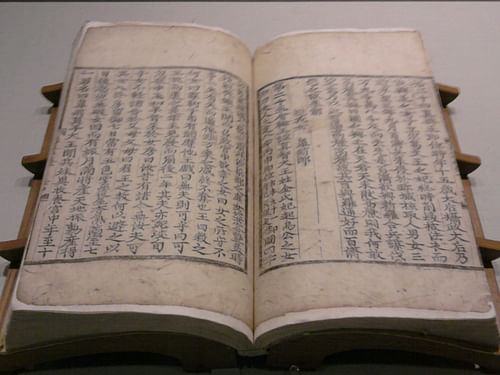
The Samguk Yusa ('Memorabilia of the Three Kingdoms') is a 13th-century CE text which covers the history and legends of Korea's founding right up to the 10th century CE. It is a sequel of sorts to the earlier Samguk sagi ('Records of the Three Kingdoms') written in the 12th century CE which is considered the first history of Korea. The Samguk yusa was mostly compiled by the Buddhist scholar-monk Iryeon and remains today an invaluable historical source and component of Korean Literature.
Authorship
The author of the Samguk yusa was the Buddhist monk Iryeon (also spelt Iryon) who lived between 1206 and 1289 CE and whose former name was Jeon Gyeon-myeong. He is thought to have completed the work by 1285 CE. An extra passage within the text is credited to his disciple Muguk. Iryeon does not explicitly state the purpose of the work, but its content would seem to be an attempt to balance the largely Confucian-view expounded by the earlier Samguk sagi with more information regarding Korea's Buddhist cultural heritage. Iryeon drew on many different types of sources, including folklore, historical documents, epigraphs, and monastery records. The oldest surviving edition of the text dates to 1512 CE.
The traditional translation of the title as 'Memorabilia' is misleading, and perhaps a more accurate title would be 'Additional Material on the Three Kingdoms' as 'yusa' usually refers to additional material added to already existing official documents. The title is also misleading in that the vast majority of the history covered concerns Buddhist legends and the history of the Silla kingdom (57-918 CE) with very little in regard to the contemporary Baekje (Paekche) and Goguryeo (Koguryo) kingdoms. There are tables of the various kings for all three kingdoms and the contemporary Gaya (Kaya) confederation, but these may be a later addition.
Subject Matter
The text covers many different areas of history with a particular focus on Buddhist legends and the folk tales of Silla. For this reason, as an accurate source of history it is somewhat dubious, but it does make, nevertheless, an invaluable contribution to the literature and legends of ancient Korea. It was written after the Mongol invasions of Korea in the first half of the 13th century CE and is perhaps indicative of the rise in interest to preserve the Korean cultural heritage. The many Buddhist stories also contain a strong moral element which may have been designed to reassure and strengthen people's faith in such troubled times.
The various section headings are: 'Strange Events' (almost half the text), 'The Coming of Buddhism' (concerned with the first Chinese Buddhist monks to visit Goguryeo and Baekje), 'Pagodas and Statues,' 'Famous Teachers,' 'Exorcisms,' 'Graces,' 'Hermits,' and 'Filial Devotion.' The first and largest section title 'Strange Events' is another peculiar choice of title as it deals with the history of Gojoseon (Old Choson), which ruled northern Korea in the second half of the first millennium BCE, Wiman Joseon, its brief successor (2nd century BCE to 108 CE), Lelang, the Chinese commandery (108-313 CE), Gaya, Goguryeo, Baekje, Balhae (Parhae), the Manchurian state 698-926 CE), the three Han federations, and six other tribes of the region. In many of these sections, the Samguk yusa reveals another great value as it frequently draws on many earlier sources which have since been lost, for example, the Karak kukki ('Record of the Karak Kingdom') composed in 1076 CE and the many works of the 8th-century CE scholar Kim Dae-mun.
Foundation Myths
The Samguk yusa is an important source for two foundation myths. There is the story of Dangun Wanggeom (Tangun), the legendary founder of Gojoseon who was born on the third day of the tenth month, which is celebrated as National Foundation Day in modern South Korea. In 2333 BCE (a purely traditional date without any archaeological evidence to support it) Dangun was born from the union of the god Hwanung and a bear transformed into a woman called Ungnyo. Korea's first great statesman is then credited with founding the Korean race and introducing good government. The Samguk yusa is the oldest known reference to this very popular and long-lasting myth. The second myth concerns King Dongmyeong who traditionally lived between 59 and 19 BCE and founded the state of Goguryeo in 37 BCE.
Chosin's Dream
As already mentioned, the Samguk yusa contains many Buddhist folk tales and perhaps the most famous is that of 'Chosin's Dream,' a classic morality tale. A monk falls in love with a magistrate's daughter, and knowing the situation is beyond hope, he prays that she will fall in love with him. Alas, his prayer goes unanswered, and the girl marries another man. Then, one night the monk dreams of the girl and she reveals that she had loved him all along and, leaving her husband, the two go away and live together. They have five children and spend 50 years together. However, the couple were always fighting poverty over these five decades which results in one daughter becoming a beggar and a son who dies of starvation. The couple now realise that they made a fatal mistake in deciding to live together and they part. Then the monk wakes up, and he visits the spot in the dream where he had buried his son. There, in the ground, he finds a small figure of Buddha. Reassured of his faith, the monk builds a monastery where he found the statue and spends the rest of his life doing good for others.
Hyangga Songs
Within the text, there are a good number of biographies, albeit often of legendary figures, illustrating the influence of earlier historical works, especially Shiji by the Chinese historian Sima Qian (c. 145 - 86 BCE). At the end of many of the biographies, there is a eulogy in the form of a folk song or hyangga. These are the oldest examples of Korean text written phonetically. Perhaps the most famous is the 45-line 'Song of Choyong' (Choyong ka), originally composed in 879 CE, where the title character is the son of the Dragon King of the Eastern Sea, who one night after a party returns home to find his beautiful wife being seduced by the Spirit of Smallpox. Choyong was forgiving, though, and, in return, the spirit promised never to enter a house which had a portrait of our hero on the door. This is the song which Choyong sang so charmingly to the spirit so that he left in peace:
Having caroused far into the night
In the moonlit capital,
I returned home and in my bed,
Behold four legs.
Two were mine;
Whose are the other two?
Formerly two were mine;
What shall be done now they are taken?
(Lee, P.H., 73)
This content was made possible with generous support from the British Korean Society.
